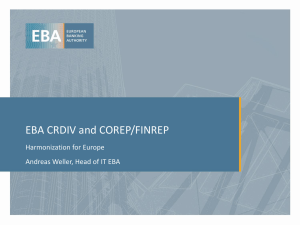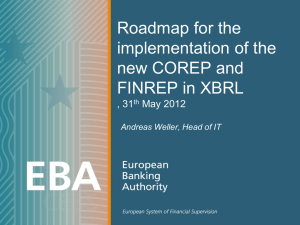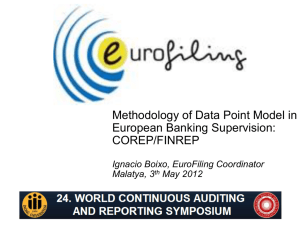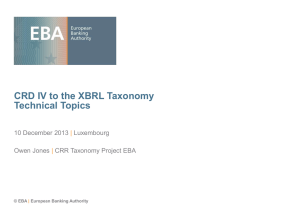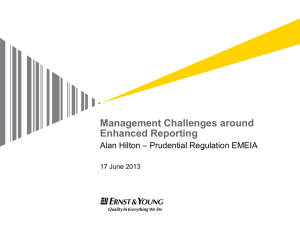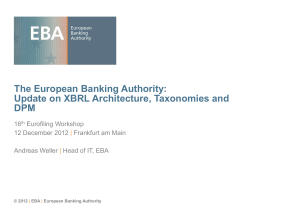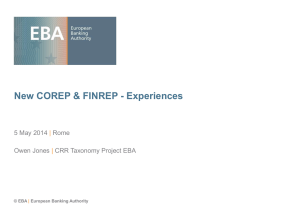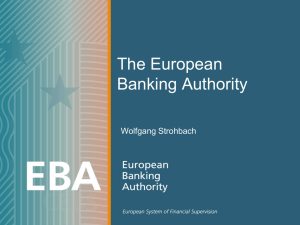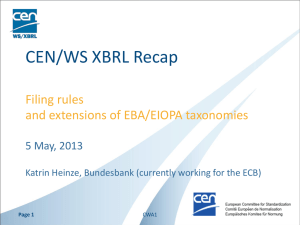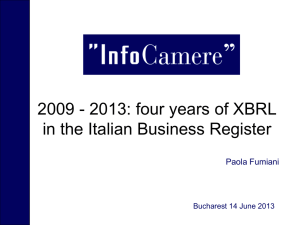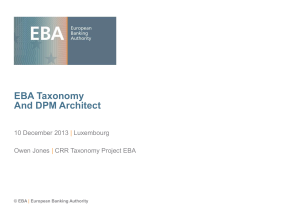FINREP and COREP V2.0
advertisement
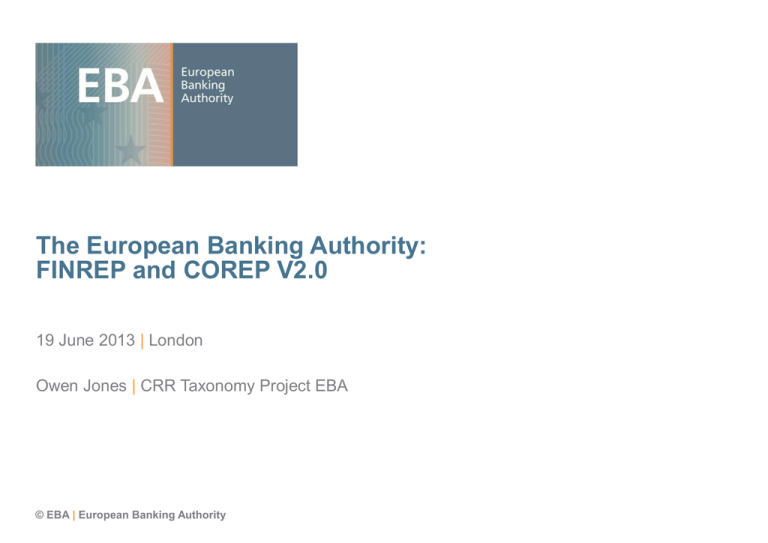
The European Banking Authority: FINREP and COREP V2.0 19 June 2013 | London Owen Jones | CRR Taxonomy Project EBA © EBA | European Banking Authority EBA XBRL Taxonomy Primary purpose: For data exchange from NSAs to EBA Regulations Templates Transmit to EBA DPM Taxonomy Report to NSA Transmit to EBA Instructions Validations EBA Business experts Understand Requirements EBA IT experts NSA IT experts Credit Institutions Many NSAs will use substantially the same for 1st level reporting 3 EBA XBRL Taxonomy Very Dimensional • 286 Primary Items • 101 Dimensions, 1500 members • 43 of 32000 data points use only 1 dimension, none use 0 Extensive use of table link base Filing indicators used at table level 4 The Frameworks COREP Capital Adequacy Group Solvency Credit Risk IP Losses Operational Risk Market Risk Large Exposures Leverage Liquidity Coverage Net Stable Funding FINREP Primary Statements Assets & Liabilities Financial Asset Disclosures & Off Balance Sheet Income & Equity Financial & Non-Financial Disclosures, OBS Forbearance Non-performance Asset Encumbrance ... ... ... ... 5 In XBRL One taxonomy / Two “taxonomies” • Common dictionary – same concepts, same dimensions used to categorise things • Different tables, different reporting units (modules). Large: 1800 files, 100MB 6 The XBRL entry points/modules (Jan 2014) COREP FINREP COREP FINREP COREP LE Capital Adequacy Group Solvency Credit Risk Operational Risk Market Risk Leverage Ratio Liquidity Coverage Large Exposures Part 1 Part 2 Part 3 Part 4 Part 5 Net Stable Funding Ratio 7 Contents of each module COREP FINREP COREP FINREP COREP LE 51 Templates 81 Tables 669 Validations 2 Templates 2 Tables 13 Validations 68 Templates 77 Tables 658 Validations Expected file size 30-100MB Expected file size 1-100MB+ Expected file size 5-10MB 8 Templates vs Tables Table linkbase • Rows/Columns/Sheets must have a unique set of dimensions • Cells are defined by the combination at the intersection Excel Templates • no restrictions, anything goes Sometimes to model a template we need to switch the definition of a column for some rows. This means we need to break up tables into parts: 9 Templates vs tables – example F 29.01 10 Understanding the requirements – from Templates 11 Understanding the requirements – from DPM DB 12 Understanding the requirements – from XBRL 13 Types of tables The frameworks contain many different kinds of tables • Simple two–dimensional tables • Tables with more complex features: • • • • Nested headings Sheets (z-axes) Open tables Open sheets 14 Simple Tables – XBRL (Instance) 15 Complex tables – Nested Headers - XBRL 16 Complex tables – Fixed Sheets - DPM 17 Complex tables – Fixed Sheets - XBRL 18 Open tables – Rows Also open sheets – e.g. top N currencies/ top N countries 19 ITS Development: Iterative Process ...so far Templates Structure checks Analysis Modeling DPM Excel Quality checks Metadata loading DPM Database Metadata extraction DPM-XBRL Generator Test results Generation XBRL Taxonomies In Progress ... 20 Current Status Early access version of the taxonomy is currently being reviewed by NSAs Receiving very useful feedback and corrections Awaiting final business changes to the DPM These will be incorporated, and a public consultation version prepared. Working to a loose target of end August for public consultation 21 Possible Concerns • Extensive use of Table Linkbase • Specification is still fluid • Implementations are currently “patchy” • The taxonomy being reviewed is based on the previous PWD • Volume of data, size of instance files, complexity of tables • Performance of tools • Availability of tools suitable for the reporting process • Manual entry / tagging will not be plausible • Integration with accounting / risk management / regulatory reporting systems needed 22 So Vendors and NSAs • Ensure you are up to date with the Table Linkbase spec • Ensure your tools are ready for volume and complexity Filers • Ensure you are planning ahead • Devise suitable processes • Contact vendors. 23 Contact information Owen Jones European Banking Authority Floor 18 | Tower 42 | 25 Old Broad Street London EC2N 1HQ | United Kingdom t +44 (0)20 7933 9900 f +44 (0)20 7382 1771 info@eba.europa.eu www.eba.europa.eu 24 Simple Tables - DPM 26 Simple Tables – XBRL (Taxonomy) 27
